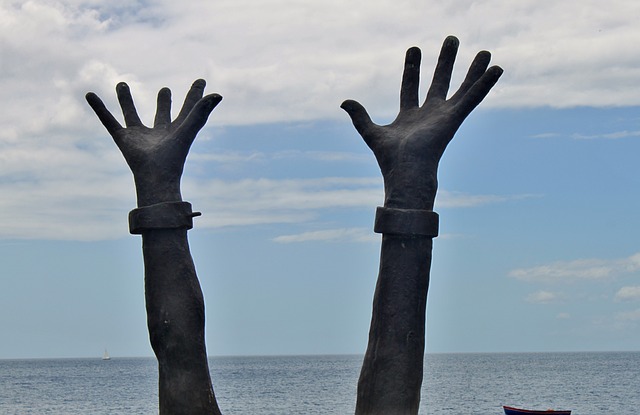Slaves were legally owned by individuals and had no personal freedoms, whereas serfs were bound to the land and were obligated to work for their lords but were not legally owned. Serfs had some rights and could not be bought or sold, while slaves could be bought, sold, and traded as property.
What is Slavery?
(Photo by British Library on Unsplash )

Slavery is a system in which one person owns another person and has the right to control their labor and their life. Slaves have no legal rights and cannot own property or make decisions for themselves. They are considered property and can be bought, sold, and traded like any other item.
Slavery has existed in many cultures throughout history, but is most famously associated with the Atlantic slave trade of the 16th to 19th centuries, in which millions of Africans were forcibly taken from their homes and transported to the Americas to work as slaves on plantations.
Origins of Slavery
The origins of slavery can be traced back thousands of years and it was practiced in many cultures throughout history. Slavery became a widespread and profitable business in the 16th and 17th centuries when European colonizers began transporting African slaves to the Americas to work on their plantations. The transatlantic slave trade brought an estimated 12 million Africans to the Americas, of which 10.7 million arrived in the territories that would become the United States.
What is Serfdom?
(Photo by Social History Archive on Unsplash )

Serfdom is a form of feudalism in which the peasant population is bound to the land and cannot leave without the permission of their lord. Serfs are not considered property, but they are tied to the land and must work for their lords in exchange for the right to live and farm on the land.
Serfdom was prevalent in Europe from the 9th to the 15th centuries and was a key aspect of the feudal system. Serfs were not allowed to own property or marry without the permission of their lord and were also required to pay taxes and perform other duties for their lords.
Origins of Serfdom
Serfdom originated in the 9th century, when the feudal system was established in Europe. The lords of the land needed a source of labor to work their fields and the serfs provided this labor in exchange for protection and the use of land. Over time, the lords became more powerful and the serfs became more dependent on them for their survival.
How are Slavery and Serfdom Different?
While slavery and serfdom may seem similar, there are several key differences between the two systems:
Ownership: In slavery, the slave is considered property and can be bought, sold, and traded like any other item. In serfdom, the serf is tied to the land but is not considered property.
Mobility: Slaves are not allowed to leave their owners and must remain with them for their entire lives. Serfs, on the other hand, are tied to the land but are not restricted in their movement in the same way.
Legal Status: Slaves have no legal rights and are completely at the mercy of their owners. Serfs have some legal rights, such as the right to marry and own property, but they are still subject to the control of their lords.
Work Requirements: Slaves are forced to work for their owners without pay, while serfs are required to work for their lords in exchange for the right to live and farm on the land.
The Abolition of Slavery and Serfdom
Slavery and serfdom were both abolished in the 19th century, although the timeline for this varied from place to place. The abolition of slavery in the United States was achieved through the Civil War and the passage of the 13th Amendment to the Constitution in 1865.
Serfdom was abolished in Russia in 1861 and in most of Europe in the late 19th century. The abolition of serfdom was often a gradual process, with lords gradually releasing their serfs from their obligations over time.
Slavery in America
Slavery in America refers to the practice of holding people in involuntary servitude as property. This practice was widespread in the Americas prior to the abolition of slavery in the 1865, and it is estimated that around 12 million people were enslaved in the Americas during this time. Slavery in America differed from other forms of slavery, such as those practiced in ancient Rome or Greece, in that it was often racialized, with black Africans being the most commonly enslaved group. The Atlantic slave trade brought millions of Africans to the Americas, where they were sold into slavery by European colonists. Slavery was a lucrative business, and it played an important role in the economies of many American colonies.
However, not all slaves in America were black Africans. Native Americans were also enslaved by Europeans, although this practice was less common than African slavery. White Americans could also be enslaved, although this was usually done through indentured servitude rather than outright ownership. Indentured servants were contracted to work for a certain period of time, after which they would be free. However, many white indentured servants ended up being forced to remain in servitude beyond their original contract due to poor working conditions and low wages.
The experience of slaves in America varied depending on a number of factors, including their race, gender, and age. Black slaves were typically treated more harshly than white slaves or Native American slaves. Women were also often subject to sexual violence by their slaveholders. Children were sometimes sold away from
The abolition of slavery
In the early 1800s, many people in the United States started to call for the abolition of slavery. At first, most Americans believed that slaves were different from serfs and did not deserve the same rights. However, as more and more people began to speak out against slavery, public opinion slowly began to change. In 1833, Britain passed a law called the Slavery Abolition Act which freed all slaves in the British Empire. This law served as an inspiration for those who were fighting against slavery in the United States. In 1865, the 13th Amendment to the Constitution was passed, which abolished slavery throughout America.
Slavery in Europe
Many people believe that slavery is a thing of the past, but the sad reality is that there are still slaves in the world today. Slavery in Europe is not as common as it once was, but it still exists in some parts of the continent.
There are two main types of slaves in Europe: those who are forced to work in agriculture and those who work in the sex industry. Agriculture is the most common form of slavery in Europe, as many migrants from Africa and Asia are brought to the continent to work on farms. These workers often have no choice but to accept whatever terms their employers offer them, as they are often in debt to the people who brought them to Europe. This makes it very difficult for them to leave their situation or negotiate better working conditions.
The sex industry is another major source of slavery in Europe. Many women and girls from Eastern Europe are trafficked into Western European countries and forced into prostitution. They may be promised a good job and a better life, but instead they find themselves trapped in a cycle of exploitation and abuse. Some of these women manage to escape their situation and start new lives, but many others are trapped for years or even decades.
Why were slaves more expensive than serfs?
The main reason slaves were more expensive than serfs was because of the increased risk involved in acquiring them. Slaves were often brought over from other countries, which made them more difficult to control and more likely to rebel. Additionally, slaves had to be fed and housed, which added to their cost. Serfs, on the other hand, were already living in the country and were not as much of a flight risk. They also did not require as much food and shelter, since they typically lived with their lord.
What’s the difference between slaves and peasants?
The two terms are often used interchangeably, but there are some key differences between slaves and serfs. For one, slaves are typically owned by an individual or family, while serfs are owned by a lord or other powerful landowner. Second, slaves can be bought and sold like property, while serfs are tied to the land they work on and cannot be bought or sold. Finally, slaves typically have few or no legal rights, while serfs have some legal protections and rights under the law.
Did serfs have more rights than slaves?
There is a common misconception that serfs were nothing more than slaves. This couldn’t be further from the truth. While it’s true that serfs were required to work on their lord’s land and give them a portion of their crops, they were not owned by their lord. They were also allowed to marry, own property, and even leave their lord’s land if they so desired.
Slaves, on the other hand, were owned by their masters. They could be bought and sold at any time and had no rights whatsoever. Their children were also born into slavery. In many cases, slaves were treated brutally and worked to death. It’s no wonder that many slave rebellions occurred throughout history.
What was a salves life like?
The Transatlantic Slave Trade
The transatlantic slave trade was a brutal and inhumane process that involved the kidnapping and forced transportation of millions of Africans to the Americas. The journey across the ocean was known as the “Middle Passage” and was infamous for its brutal conditions. Slaves were packed into tight quarters with little food or water, and disease and death were rampant. Those who survived the journey were then sold into slavery in the Americas.
Life on the Plantation
Life on a plantation was a daily struggle for slaves. They were forced to work long hours in the fields, planting, harvesting and picking cotton. They were also expected to perform household chores, such as cooking, cleaning, and caring for the plantation owner’s children. Slaves were subjected to brutal punishments if they failed to meet the demands of their owners, including beatings, whippings, and even death.
Family Life for Slaves
The family life of a slave was constantly under threat. Slaves were often separated from their families and sold to different owners, never to see their loved ones again. Children were taken from their mothers and raised by other slaves or sent to work in the fields. Marriage was not recognized by slave owners and families could be torn apart at any moment. Despite these obstacles, slaves created tight-knit communities and found ways to preserve their cultural heritage through music, storytelling, and religious practices.
Resistance and Escape
Despite the harsh conditions they faced, slaves found ways to resist their oppressors. Some slaves escaped to freedom through the Underground Railroad, a network of safe houses and secret routes that helped slaves reach freedom in the North. Others rebelled against their owners, staging uprisings and revolts. The most famous of these was Nat Turner’s rebellion in 1831, in which Turner and a group of followers killed over 50 white plantation owners.
The Abolition Movement
The abolition movement was a widespread and sustained effort to end slavery. It was led by people of all races and backgrounds, including former slaves, abolitionists, and religious leaders. The movement gained momentum in the late 1700s and early 1800s and was a key factor in the eventual end of slavery in the United States.
The Emancipation Proclamation
In 1863, President Abraham Lincoln issued the Emancipation Proclamation, declaring that all slaves in Confederate-held territory were to be “forever free.” This marked a turning point in the fight against slavery and paved the way for the eventual passage of the 13th Amendment, which officially abolished slavery in the United States.
What was a serfs life like?
Life on the Manor
Serfs were tied to the manor and were forbidden from leaving without the permission of their lord. They were required to work a set number of days each week on the lord’s lands and were also expected to perform other duties, such as building and repairing buildings, and providing food and supplies for their lord’s household. In return, they were given the use of a small plot of land, where they could grow crops to feed their families.
Family Life for Serfs
Serfs were not allowed to marry without the permission of their lord and their marriages were often arranged to serve the interests of the manor. Children of serfs were born into the same status as their parents and were also forced to work for their lord. Despite these restrictions, serfs formed close-knit communities and looked after one another in times of need.
Resistance and Rebellion
Despite the harsh conditions they faced, serfs found ways to resist their lords. Some ran away to nearby cities, where they could live as free people, while others banded together to stage uprisings and rebellions. The most famous of these was the Peasant’s Revolt of 1381, in which tens of thousands of serfs marched on London to demand an end to their bondage.
The Decline of Serfdom
The decline of serfdom began in the late Middle Ages, as lords began to see the benefits of freeing their serfs. Some lords freed their serfs in exchange for money, while others did so in order to attract settlers to their lands. The growth of trade and commerce also played a role in the decline of serfdom, as lords realized that free labor was more profitable than bonded labor.
The Legacy of Serfdom
The legacy of serfdom can still be felt today, as many of the social and economic inequalities that existed during the Middle Ages continue to persist. Serfdom was a brutal and inhumane system that treated people as mere property and denied them the basic freedoms and rights that we take for granted today. Despite this, the resilience and resistance of the serfs serves as a reminder of the power of the human spirit and the enduring struggle for freedom and justice.
Frequently asked questions about slavery and serfdom
Is a serf similar to a servant?
The answer to this question is both yes and no. Like servants, serfs were bound to the land they worked on and were not free to leave. They also had to obey their lord’s commands. However, serfs were not owned by their lord like slaves were. Instead, they paid rent or taxes to their lord in exchange for the use of his land.
What did female serfs do?
Female serfs were responsible for many of the same domestic chores as their male counterparts, such as cooking, cleaning, and caring for children. In addition to these duties, women also worked in the fields alongside men and performed other tasks such as spinning wool and weaving cloth. While the life of a female serf was certainly not easy, it was not as brutal or demanding as that of a female slave.
Were female slaves treated differently than male slaves?
In general, female slaves were not treated as harshly as male slaves. They were often given more freedom and allowed to perform less strenuous work. Female slaves were also more likely to be educated and given skilled jobs. However, there were some instances in which female slaves were treated worse than male slaves. For example, they were sometimes sexually abused by their owners or forced to work in the fields alongside men.
What was done to slaves who tried to escape?
If a slave attempted to escape, they would be subject to punishment. This could include beatings, whippings, or other forms of physical abuse. In some cases, slaves who tried to escape would be killed.








